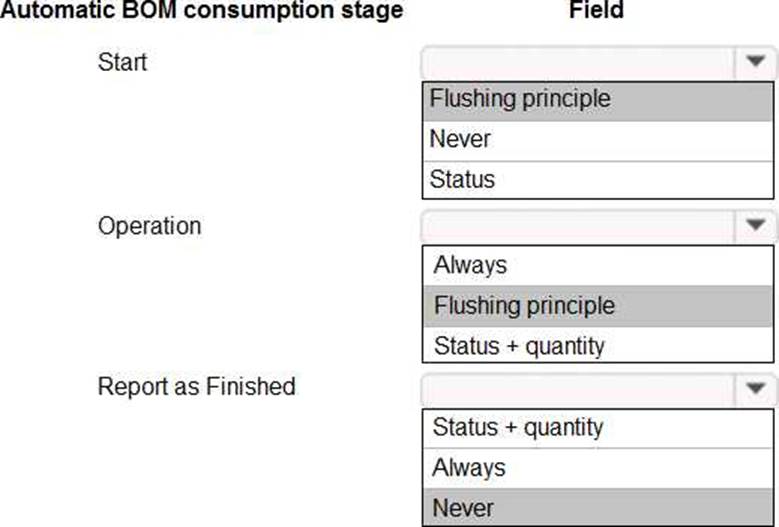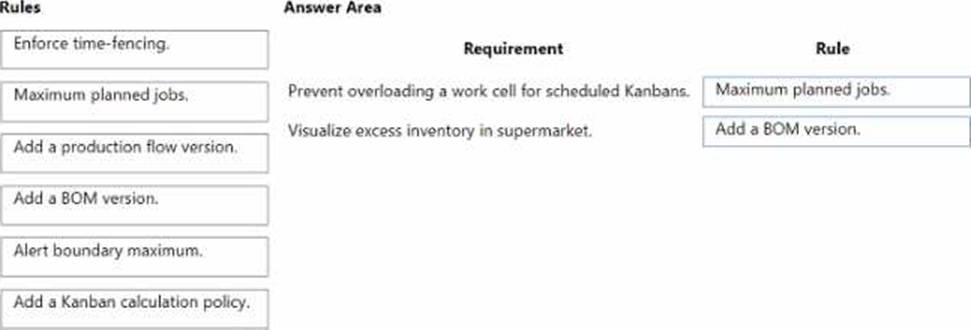Microsoft MB-335 Übungsprüfungen
Zuletzt aktualisiert am 26.04.2025- Prüfungscode: MB-335
- Prüfungsname: Microsoft Dynamics 365 Supply Chain Management Functional Consultant Expert
- Zertifizierungsanbieter: Microsoft
- Zuletzt aktualisiert am: 26.04.2025
HOTSPOT –
Case Study
This is a case study. Case studies are not timed separately. You can use as much exam time as you would like to complete each case. However, there may be additional case studies and sections on this exam. You must manage your time to ensure that you are able to complete all questions included on this exam in the time provided.
To answer the questions included in a case study, you will need to reference information that is provided in the case study. Case studies might contain exhibits and other resources that provide more information about the scenario that is described in the case study. Each question is independent of the other questions in this case study.
At the end of this case study, a review screen will appear. This screen allows you to review your answers and to make changes before you move to the next section of the exam. After you begin a new section, you cannot return to this section.
To start the case study
To display the first question in this case study, click the Next button. Use the buttons in the left pane to explore the content of the case study before you answer the questions. Clicking these buttons displays information such as business requirements, existing environment, and problem statements. If the case study has an All Information tab, note that the information displayed is identical to the information displayed on the subsequent tabs. When you are ready to answer a question, click the Question button to return to the question.
Background
Fabrikam Inc. is a manufacturer of sanitation cleaning solutions and equipment including carpet/floor cleaners, pressure washers, scrubbers and vacuums.
Fabrikam Inc. is a single legal entity based in New York city.
_ Current environment
Products manufactured
• Cleaning equipment o floor cleaner
o pressure washers o scrubbers
o vacuums
• Liquid cleaning solutions o No scent
o Orange scent (subcontracted to a vendor named Vendor A)
o Pine scent (subcontracted to a vendor named Vendor A)
The production quantity for the finished unscented liquid cleaning solution is 40-liters. Ingredient C ‚or unscented liquid cleaning solution Is stored in inventory in 50-liter barrels and allocated in 50-liter increments. Two barrels of Ingredient C are uses to produce a barrel of unscented liquid cleaning solution.
Production sites
• The Eastern United States facility manufactures equipment.
• The Western United States facility manufactures liquid cleaning solutions.
• Raw materials and finished products are stocked at the warehouse and distributed from the warehouse.
Warehouse facilities
The warehouse consists of the following zones:

_ Requirements
Cleaning equipment manufacturing
You identify the following require merits for manufacturing cleaning equipment:
• Production is Make to Stock and must be scheduled at an operational level.
• Machine equipment is produced on an assembly line. Scheduling must be based on production orders.
• Finished products must be packaged and shipped directly from the warehouse.
• To reduce delivery times and excess inventory, equipment must be produced as needed.
• The ability to schedule production must be based on resource capacity and the availability of required materials.
• Production order operations must be scheduled to start only when capacity and materials are available at the same time and in the required quantities.
Liquid cleaning solution manufacturing
• Production is Make lo Order and is scheduled at the job level. Products must be manufactured in batches.
• Finished products must be packaged and shipped directly from the warehouse.
• You must be able to calculate the estimated consumption of ingredients and ensure that the
amount is divisible by the number of units the raw material «s available.
• Formula changes must be reviewed and approved. You must ensure that approved formulas cannot be deleted or edited. Approved formulas may be deactivated.
• An ingredient used to manufacture unscented cleaning solution is defined as a restricted product. You must be able to automatically print a product safety data sheet (PSDS) with the packing slip for any order that includes unscented cleaning solution.
• Production must be scheduled to start by date and time according to the order that is specified by the production route.
• You must implement a scheduled Kanban rule that meets the following requirements:
o Prevent overloading a work cell for scheduled Kanbans. o Visualize excess inventory in a supermarket.
o Store products in supermarkets before they are consumed or shipped.
• You must link relevant financial dimension data to the inventory transactions at each site to ensure that you can trace profit and loss figures directly to East site and West site respectively.
• You must set up production operations for sub-contracting of Pine scent and Orange scent solution to Vendor A to ensure that a purchase order is automatically created based on estimation of a production order.
Costing
• The price of raw materials used for manufacturing unscented cleaning solution must be tracked based upon commodity exchange pricing. The margin and cost multiplier must be set up for commodity traded raw material.
• You must set up cost calculation groups to ensure that indirect costs that originate in the manufacturing of finished goods are recognized and absorbed into the product cost.
• The production manager needs to set up picking list journals and BOM item consumption.
Reporting
• Production control parameters must be setup for reporting of automatic BOM and Route consumption.
• You must create reports that include information about cost records and categories for items, and calculation formulas for indirect costs.
• You must treat manufactured items as purchased items for cost roll-up purposes during BOM calculations and reporting.
• You must configure automatic route consumption in connection with the automatic running of Report as finished.
Inventory control
You must not be required to track the tot number for items when you enter inventory information into the system. Lot numbers for items must be entered when items are picked from inventory.
Issues
Users report the following issues:
• The production manager observes that items are being deducted from inventory two times on production jobs. A shop supervisor mistakenly registers the process for assembling batteries for the pressure washers to Registered as prepared. You must reschedule the process for a future date.
• Customer1 orders 20 barrels of unscented solution. The order is confirmed. Production must be scheduled to start on December 21 to meet the customer’s delivery deadline.
• User2 reports that costs for manufactured items are twice as high as expected.
• User 1 reports that the formula for the liquid cleaning solution sometimes changes during production. You must enforce the policies regarding formula editing for current and future use.
You need to resolve the production manager issue.
How should you configure manufacturing execution? To answer, select the appropriate option in the answer area. NOTE: Each correct selection is worth one point.
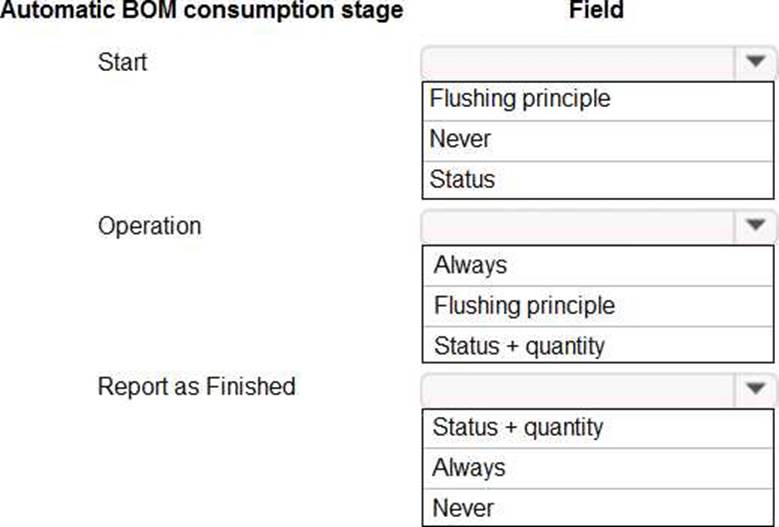
HOTSPOT
Case Study
This is a case study. Case studies are not timed separately. You can use as much exam time as you would like to complete each case. However, there may be additional case studies and sections on this exam. You must manage your time to ensure that you are able to complete all questions included on this exam in the time provided.
To answer the questions included in a case study, you will need to reference information that is provided in the case study. Case studies might contain exhibits and other resources that provide more information about the scenario that is described in the case study. Each question is independent of the other questions in this case study.
At the end of this case study, a review screen will appear. This screen allows you to review your answers and to make changes before you move to the next section of the exam. After you begin a new section, you cannot return to this section.
To start the case study
To display the first question in this case study, click the Next button. Use the buttons in the left pane to explore the content of the case study before you answer the questions. Clicking these buttons displays information such as business requirements, existing environment, and problem statements. If the case study has an All Information tab, note that the information displayed is identical to the information displayed on the subsequent tabs. When you are ready to answer a question, click the Question button to return to the question.
Background
Fabrikam Inc. is a manufacturer of sanitation cleaning solutions and equipment including carpet/floor cleaners, pressure washers, scrubbers and vacuums.
Fabrikam Inc. is a single legal entity based in New York city.
_ Current environment
Products manufactured
• Cleaning equipment o floor cleaner
o pressure washers o scrubbers
o vacuums
• Liquid cleaning solutions o No scent
o Orange scent (subcontracted to a vendor named Vendor A)
o Pine scent (subcontracted to a vendor named Vendor A)
The production quantity for the finished unscented liquid cleaning solution is 40-liters. Ingredient C ‚or unscented liquid cleaning solution Is stored in inventory in 50-liter barrels and allocated in 50-liter increments. Two barrels of Ingredient C are uses to produce a barrel of unscented liquid cleaning solution.
Production sites
• The Eastern United States facility manufactures equipment.
• The Western United States facility manufactures liquid cleaning solutions.
• Raw materials and finished products are stocked at the warehouse and distributed from the warehouse.
Warehouse facilities
The warehouse consists of the following zones:

_ Requirements
Cleaning equipment manufacturing
You identify the following require merits for manufacturing cleaning equipment:
• Production is Make to Stock and must be scheduled at an operational level.
• Machine equipment is produced on an assembly line. Scheduling must be based on production orders.
• Finished products must be packaged and shipped directly from the warehouse.
• To reduce delivery times and excess inventory, equipment must be produced as needed.
• The ability to schedule production must be based on resource capacity and the availability of required materials.
• Production order operations must be scheduled to start only when capacity and materials are available at the same time and in the required quantities.
Liquid cleaning solution manufacturing
• Production is Make lo Order and is scheduled at the job level. Products must be manufactured in batches.
• Finished products must be packaged and shipped directly from the warehouse.
• You must be able to calculate the estimated consumption of ingredients and ensure that the
amount is divisible by the number of units the raw material «s available.
• Formula changes must be reviewed and approved. You must ensure that approved formulas cannot be deleted or edited. Approved formulas may be deactivated.
• An ingredient used to manufacture unscented cleaning solution is defined as a restricted product. You must be able to automatically print a product safety data sheet (PSDS) with the packing slip for any order that includes unscented cleaning solution.
• Production must be scheduled to start by date and time according to the order that is specified by the production route.
• You must implement a scheduled Kanban rule that meets the following requirements:
o Prevent overloading a work cell for scheduled Kanbans. o Visualize excess inventory in a supermarket.
o Store products in supermarkets before they are consumed or shipped.
• You must link relevant financial dimension data to the inventory transactions at each site to ensure that you can trace profit and loss figures directly to East site and West site respectively.
• You must set up production operations for sub-contracting of Pine scent and Orange scent solution to Vendor A to ensure that a purchase order is automatically created based on estimation of a production order.
Costing
• The price of raw materials used for manufacturing unscented cleaning solution must be tracked based upon commodity exchange pricing. The margin and cost multiplier must be set up for commodity traded raw material.
• You must set up cost calculation groups to ensure that indirect costs that originate in the manufacturing of finished goods are recognized and absorbed into the product cost.
• The production manager needs to set up picking list journals and BOM item consumption.
Reporting
• Production control parameters must be setup for reporting of automatic BOM and Route consumption.
• You must create reports that include information about cost records and categories for items, and calculation formulas for indirect costs.
• You must treat manufactured items as purchased items for cost roll-up purposes during BOM calculations and reporting.
• You must configure automatic route consumption in connection with the automatic running of Report as finished.
Inventory control
You must not be required to track the tot number for items when you enter inventory information into the system. Lot numbers for items must be entered when items are picked from inventory.
Issues
Users report the following issues:
• The production manager observes that items are being deducted from inventory two times on production jobs. A shop supervisor mistakenly registers the process for assembling batteries for the pressure washers to Registered as prepared. You must reschedule the process for a future date.
• Customer1 orders 20 barrels of unscented solution. The order is confirmed. Production must be scheduled to start on December 21 to meet the customer’s delivery deadline.
• User2 reports that costs for manufactured items are twice as high as expected.
• User1 reports that the formula for the liquid cleaning solution sometimes changes during production. You must enforce the policies regarding formula editing for current and future use.
You need to configure lot number control for inventory.
Which option should you use?
- A . Physical inventory
- B . Blank receipt allowed
- C . Blank issue allowed
- D . Primary stocking
DRAG DROP –
Case Study
This is a case study. Case studies are not timed separately. You can use as much exam time as you would like to complete each case. However, there may be additional case studies and sections on this exam. You must manage your time to ensure that you are able to complete all questions included on this exam in the time provided.
To answer the questions included in a case study, you will need to reference information that is provided in the case study. Case studies might contain exhibits and other resources that provide more information about the scenario that is described in the case study. Each question is independent of the other questions in this case study.
At the end of this case study, a review screen will appear. This screen allows you to review your answers and to make changes before you move to the next section of the exam. After you begin a new section, you cannot return to this section.
To start the case study
To display the first question in this case study, click the Next button. Use the buttons in the left pane to explore the content of the case study before you answer the questions. Clicking these buttons displays information such as business requirements, existing environment, and problem statements. If the case study has an All Information tab, note that the information displayed is identical to the information displayed on the subsequent tabs. When you are ready to answer a question, click the Question button to return to the question.
Background
Fabrikam Inc. is a manufacturer of sanitation cleaning solutions and equipment including carpet/floor cleaners, pressure washers, scrubbers and vacuums.
Fabrikam Inc. is a single legal entity based in New York city.
_ Current environment
Products manufactured
• Cleaning equipment o floor cleaner
o pressure washers o scrubbers
o vacuums
• Liquid cleaning solutions o No scent
o Orange scent (subcontracted to a vendor named Vendor A)
o Pine scent (subcontracted to a vendor named Vendor A)
The production quantity for the finished unscented liquid cleaning solution is 40-liters. Ingredient C ‚or unscented liquid cleaning solution Is stored in inventory in 50-liter barrels and allocated in 50-liter increments. Two barrels of Ingredient C are uses to produce a barrel of unscented liquid cleaning solution.
Production sites
• The Eastern United States facility manufactures equipment.
• The Western United States facility manufactures liquid cleaning solutions.
• Raw materials and finished products are stocked at the warehouse and distributed from the warehouse.
Warehouse facilities
The warehouse consists of the following zones:

_ Requirements
Cleaning equipment manufacturing
You identify the following require merits for manufacturing cleaning equipment:
• Production is Make to Stock and must be scheduled at an operational level.
• Machine equipment is produced on an assembly line. Scheduling must be based on production orders.
• Finished products must be packaged and shipped directly from the warehouse.
• To reduce delivery times and excess inventory, equipment must be produced as needed.
• The ability to schedule production must be based on resource capacity and the availability of required materials.
• Production order operations must be scheduled to start only when capacity and materials are available at the same time and in the required quantities.
Liquid cleaning solution manufacturing
• Production is Make lo Order and is scheduled at the job level. Products must be manufactured in batches.
• Finished products must be packaged and shipped directly from the warehouse.
• You must be able to calculate the estimated consumption of ingredients and ensure that the
amount is divisible by the number of units the raw material «s available.
• Formula changes must be reviewed and approved. You must ensure that approved formulas cannot be deleted or edited. Approved formulas may be deactivated.
• An ingredient used to manufacture unscented cleaning solution is defined as a restricted product. You must be able to automatically print a product safety data sheet (PSDS) with the packing slip for any order that includes unscented cleaning solution.
• Production must be scheduled to start by date and time according to the order that is specified by the production route.
• You must implement a scheduled Kanban rule that meets the following requirements:
o Prevent overloading a work cell for scheduled Kanbans. o Visualize excess inventory in a supermarket.
o Store products in supermarkets before they are consumed or shipped.
• You must link relevant financial dimension data to the inventory transactions at each site to ensure that you can trace profit and loss figures directly to East site and West site respectively.
• You must set up production operations for sub-contracting of Pine scent and Orange scent solution to Vendor A to ensure that a purchase order is automatically created based on estimation of a production order.
Costing
• The price of raw materials used for manufacturing unscented cleaning solution must be tracked based upon commodity exchange pricing. The margin and cost multiplier must be set up for commodity traded raw material.
• You must set up cost calculation groups to ensure that indirect costs that originate in the manufacturing of finished goods are recognized and absorbed into the product cost.
• The production manager needs to set up picking list journals and BOM item consumption.
Reporting
• Production control parameters must be setup for reporting of automatic BOM and Route consumption.
• You must create reports that include information about cost records and categories for items, and calculation formulas for indirect costs.
• You must treat manufactured items as purchased items for cost roll-up purposes during BOM calculations and reporting.
• You must configure automatic route consumption in connection with the automatic running of Report as finished.
Inventory control
You must not be required to track the tot number for items when you enter inventory information into the system. Lot numbers for items must be entered when items are picked from inventory.
Issues
Users report the following issues:
• The production manager observes that items are being deducted from inventory two times on production jobs. A shop supervisor mistakenly registers the process for assembling batteries for the pressure washers to Registered as prepared. You must reschedule the process for a future date.
• Customer1 orders 20 barrels of unscented solution. The order is confirmed. Production must be scheduled to start on December 21 to meet the customer’s delivery deadline.
• User2 reports that costs for manufactured items are twice as high as expected.
• User 1 reports that the formula for the liquid cleaning solution sometimes changes during production. You must enforce the policies regarding formula editing for current and future use.
You need to implement the scheduled Kanban requirements.
Which rules should you use? To answer, drag the appropriate rules to the correct requirements. Each rule may be used once, more than once, or not at all. You may need to drag the split bar between panes or scroll to view content. NOTE: Each correct selection is worth one point.
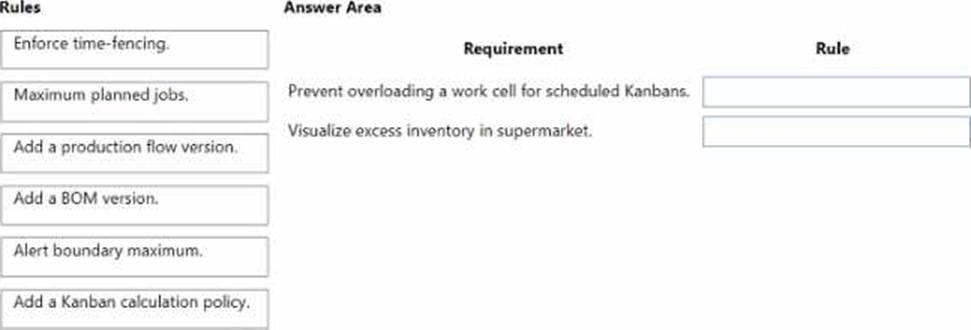
A company produces multiple products that require an installation kit that includes 50 components.
The company does not want to include these 50 components in every Bill of materials (BOM). You have a BOM kit that includes all 50 components, but you do not want it to produce a separate production order.
You need to set up the product BOM for the finished good.
What should you do?
- A . Change the coverage group on the kit item to Manual.
- B . Select Phantom on the engineering fast tab on the kit item.
- C . Change the line type to Pegged supply.
- D . Change the line type to Phantom.
HOTSPOT
Case Study
This is a case study. Case studies are not timed separately. You can use as much exam time as you would like to complete each case. However, there may be additional case studies and sections on this exam. You must manage your time to ensure that you are able to complete all questions included on this exam in the time provided.
To answer the questions included in a case study, you will need to reference information that is provided in the case study. Case studies might contain exhibits and other resources that provide more information about the scenario that is described in the case study. Each question is independent of the other questions in this case study.
At the end of this case study, a review screen will appear. This screen allows you to review your answers and to make changes before you move to the next section of the exam. After you begin a new section, you cannot return to this section.
To start the case study
To display the first question in this case study, click the Next button. Use the buttons in the left pane to explore the content of the case study before you answer the questions. Clicking these buttons displays information such as business requirements, existing environment, and problem statements. If the case study has an All Information tab, note that the information displayed is identical to the information displayed on the subsequent tabs. When you are ready to answer a question, click the Question button to return to the question.
Background
Adventure Works Cycles is a high-end bicycle manufacturer in North America. Their standard model bicycles are available year-round. Limited-edition bicycle models are released several times a year to boutique retailers domestically.
Adventure Works has had the most success with their limited-edition bicycles. These bicycles have high margins, are in high demand, and have a strong following with the younger generation biking community.
Current environment
General
Adventure Works expects to triple their manufacturing capabilities in the next few years due to increasing demand. The company plans to invest in Dynamics 365 Finance, Dynamics 365 Supply Chain Management, and the Power Platform products to migrate from a custom-built enterprise resource planning (ERP) solution and Microsoft Excel worksheets.
Adventure Works sells only to the United States and Canada. Despite their limited market, they cannot keep up with current demand. Over time, they want to expand their market to remain pro table.
Adventure Works has no capabilities or budget to undertake any development beyond Excel formula-level tasks.
Bicycle manufacturing
• Bicycle models are measured and reported against how well a single model performs as a sum of all the variations of that model. For example, the Street Kid YOLO model sold 25,000 units in 2019 across all variations of the product, but the Purple Female frame made up 30 percent of that model’s sales.
• The Street Kid YOLO models sell in different volumes depending on the market.
• The creation of production orders for bicycles occurs monthly and is based on historical sales.
• Each part of a bicycle’s assembly occurs at a different station in the Adventure Works production facility.
• A piece of paper that has eight sections accompanies a bicycle throughout the manufacturing process. As each step is completed, the respective section is completed and signed off by a production worker.
• The completed paper is used in the put-away process by the warehouse workers.
Financials
• The standard model and limited-edition bicycle teams are separate operating units within the manufacturing division. Financials are tracked and reported separately even though they are produced and sold in the same sales channels.
• Updates to the standard model bicycle models are created when a part for a bicycle becomes unavailable. This can change the cost of the product.
• An updated model of a bicycle with new parts will be maintained as a new item and have a new price. However, it will look like the exact same product to retailers and distributors.
Manufacturing process
The bicycle manufacturing process is shown in the following graphic:

Limited-edition bicycle process
The limited-edition bicycles are made up of an Adventure Works custom frame with all other parts created by local artists and manufacturers.
• Each bicycle has a unique set of new items that make up the bill of materials (BOM) because all parts are created to specification.
• A single pilot limited-edition bicycle is created as a proof of concept.
• Adventure Works occasionally reuses components from existing bicycles, but most limited-edition bicycles are made of handcrafted components designed to specifications.
• Each limited-edition bicycle is built, and hand signed by a single Adventure Works artisan.
• Sales price must be auto calculated after the cost price is derived.
• Before creating the proof of concept limited-edition bicycle, the approximate sales price needs to be determined through a cost-plus 20 percent calculation.
• All items except for the frame in the prototype process are considered finished items and can be sold individually.
• The frame items require modifications in accordance with the manufacturing process as well as painting.
• Each Adventure Works limited-edition bicycle artisan is scheduled to create a specific number of bicycles in a production run that must be completed by a certain date.
• Limited-edition bicycle artisans work exclusively on a given run of limited-edition bicycles and are not able to work on other tasks.
Limited-edition bicycle BOM assembly process
The prototype process for the limited-edition bicycles is shown in the following graphic:
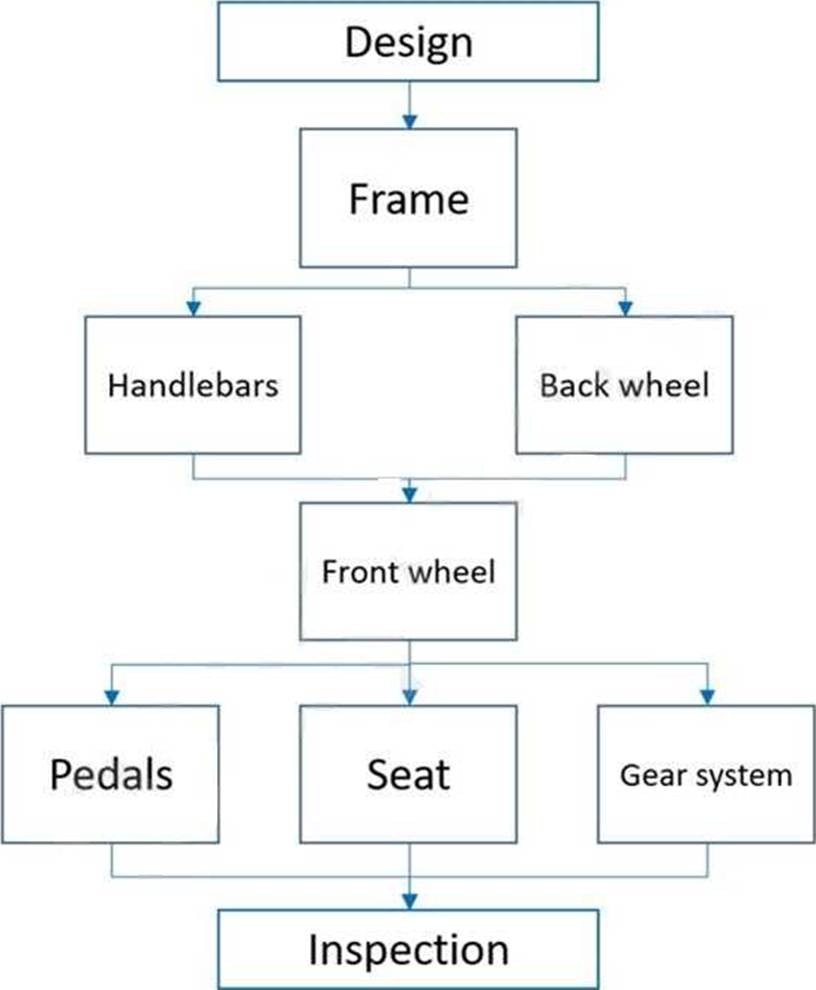
Requirements
General
• Adventure Works will consist of three legal entities: the primary legal entity of the United States (AWUS), sales in Canada (AWCA), and an international expansion (AWIN).
• AWIN must be able to sell only standard model bicycles.
• AWUS and AWCA must be able to sell both standard model and limited-edition bicycles.
• Warehouse workers must use the Warehouse Management mobile application to manage all inventory inbound and outbound from the warehouse.
Bicycle manufacturing
• The handlebars, back wheels, and front wheels must not change for any of the bicycle model configurations.
• Standard model bicycle production scheduling must be configured to start as soon as possible.
• Bicycle components must be automatically reserved when the item is released to the production floor.
• Standard model bicycle production must be automatically created on a predefined schedule.
• As soon as bicycles are completed, they must be available to fulfill the backlog of orders.
• Limited-edition bicycle production must be configured to meet the end date for when the bicycles must be completed.
• Production orders need to track financials by standard model or limited-edition bicycle manufacturing teams.
• The system must log the immediate consumption of BOMs for traceability.
• All inventory is warehouse enabled.
• Finished goods are reported as finished by the warehouse worker who picks up the finished product from the packaging area.
• Finished products must automatically have put-away work completed for them.
New limited-edition bicycle process
Adventure Works is creating a new, limited-edition bicycle to commemorate the company’s tenth anniversary. The limited-edition bicycle will be designed for charity events and be produced for the summer season.
• The bicycle must be available in men’s, women’s, and unisex frame styles. It will be painted in one of 50 hand-painted designs representing the charity of the customer’s choosing.
• A limited run of 100 bicycles must be created.
• The limited-edition bicycles must use the same production process as the standard model bicycles.
• The limited-edition bicycles must use the same parts used for previous limited-edition bicycles, except for the unique paint colors.
• Frames must be painted in-house.
• Five painting options are available only in the unisex frame style.
New limited-edition bicycle orders
• Customers must be able to place sales orders for the item in the chosen frame configuration, including style and color.
• When an order for the new limited-edition bicycle is created, payment must be provided.
• An approval for an order must exist for the order to be processed
• Upon approval of an order, production must start immediately and not require re-entry of data.
You need to configure the scheduling settings for the new limited-edition bicycles for the summer season.
Which configurations should you use? To answer, select the appropriate options in the answer area. NOTE: Each correct selection is worth one point.
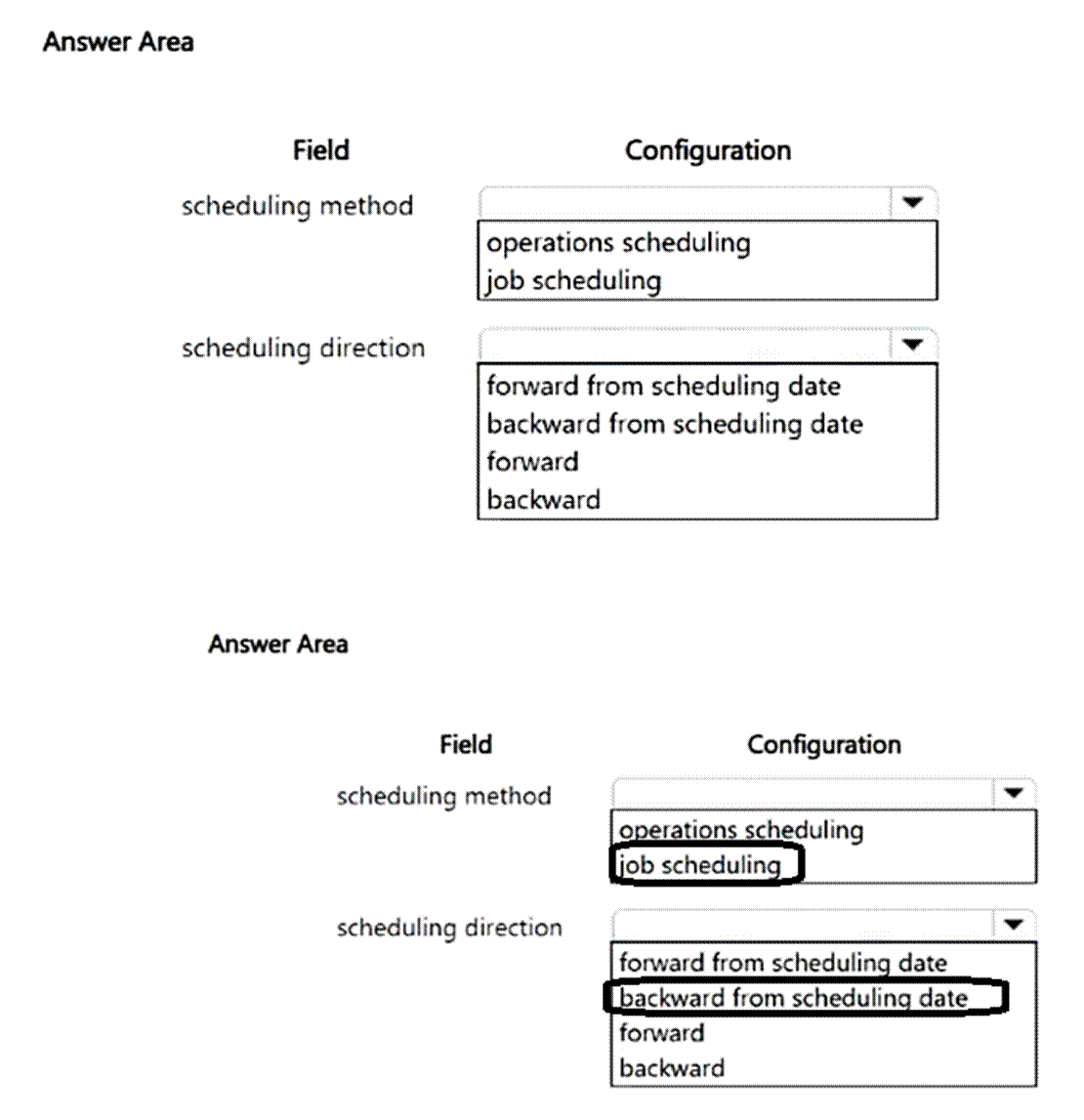
You are the production scheduler at a manufacturing company. The company is not using advanced warehousing.
You have firmed a planned production order from master planning. The order is ready to be processed.
You now need to process the order in production control.
What should you do first?
- A . Start the order.
- B . Estimate the order.
- C . Schedule the order.
- D . Report the order as finished.
HOTSPOT –
A company implements Dynamics 365 Supply Chain Management.
You must use functionality in the system for group production runs to prevent downtime and excessive cleaning of the machines on the production line.
You need to set up the system.
Which behaviors should you expect? To answer, select the appropriate options in the answer area. NOTE: Each correct selection is worth one point.

A manufacturing company uses time and attendance in Dynamics 365 Supply Chain Management.
The company requires that employees register time against each machine on the shop floor.
You need to configure the system so that employees can register time.
Which two configurations must be set up? Each answer represents a partial solution. NOTE: Each correct selection is worth one point.
- A . time registration workers
- B . registration work ow
- C . machines as a resource
- D . electronic timecard parameter
You are using the manufacturing execution module in Dynamics 365 Supply Chain Management.
License plate labels must be printed for products in the Report as finished step.
You need to use the manufacturing execution functionality that meets this requirement.
What should you use?
- A . License plates
- B . Job card device
- C . Operations schedules
- D . Production waves
DRAG DROP
You are the product design manager for a computer manufacturer.
Your new laptop model is configurable. There are restrictions on which hardware components can be selected depending on the model. You create configuration groups for hardware and software.
You need to create a new laptop item number and configurations.
In which order should you perform the actions? To answer, move all actions from the list of actions to the answer area and arrange them in the correct order.


